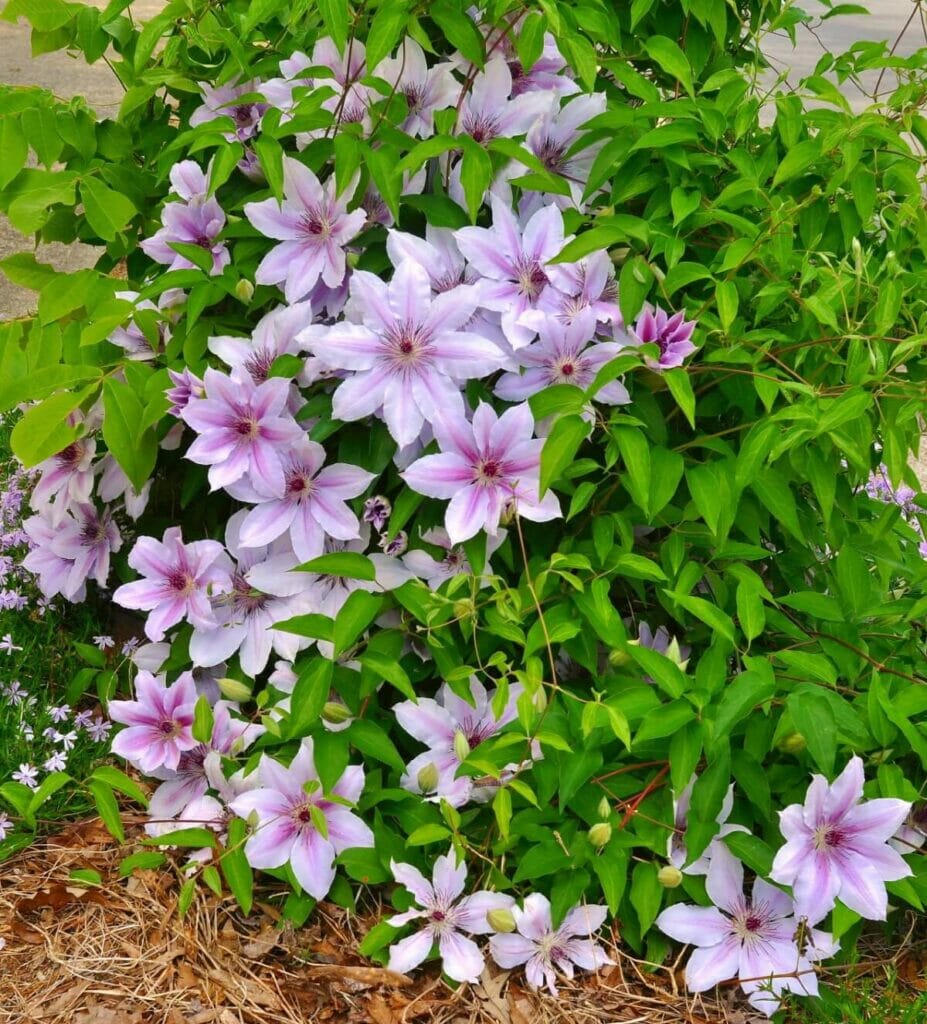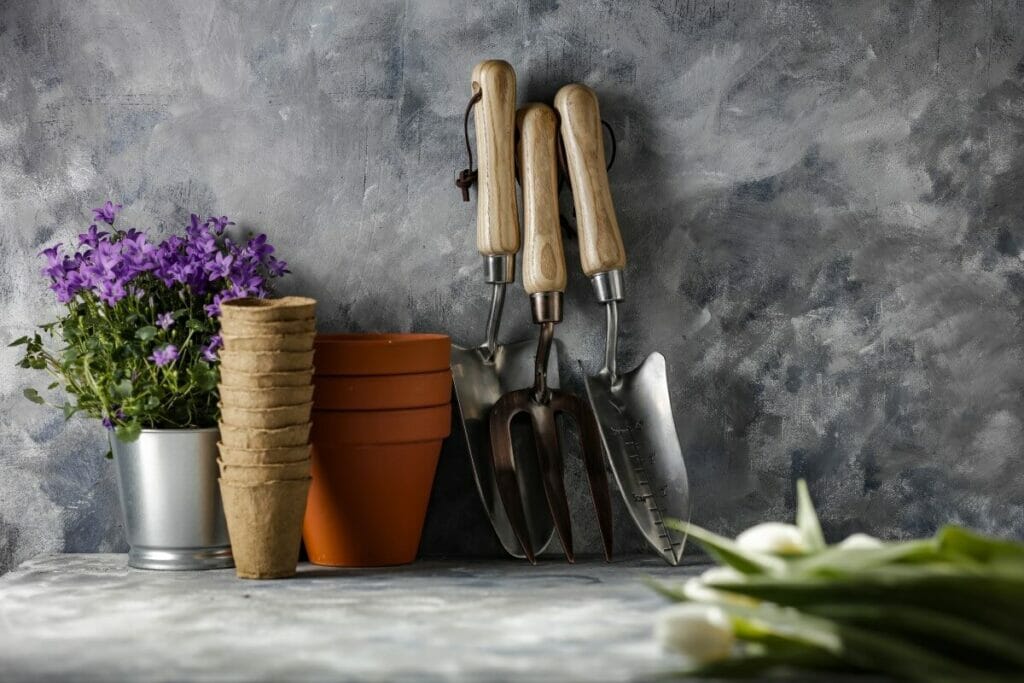Growing Clematis Nelly Moser: Home Gardening & Care Guide
If you have your eye on Clematis plants, why not go for the one with the biggest blooms? That’s Clematis Nelly Moser. It’s popular for its showy star-shaped flowers and generous blooming season. Here, I’ll take you through everything you need to know about growing and caring for Clematis Nelly Moser, including planting, soil considerations, light preferences, feeding, pruning, and over-winter care.

Clematis Nelly Moser Plant Care Basics:
| Botanical Name: | Clematis ‘Nelly Moser’ |
| Also Known As: | Nelly Moser, Early Large-Flowered Clematis, Nelly Moser Clematis |
| Hardiness Zones: | USDA zones 4 to 9 |
| Flowering Months: | Late spring, around May to the end of June. Usually has a second bloom cycle in early fall. |
| Growing Difficulty: | Easy. Suitable for beginners. |
| Type of Plant: | Perennial deciduous vine |
| Light Requirements: | Enjoys plenty of sunlight but grows best with light shade. |
| Temperature and Humidity: | Thrives at various temperatures and humidity levels—Winter-hardy up to -30 degrees Fahrenheit. |
| Watering Needs: | Needs regular watering while young, around once a week unless your area receives heavy rainfall. Reduce the watering schedule when the plant reaches maturity. |
| Soil Preferences: | Moist yet well-draining soils that are either neutral or slightly alkaline or around 5.5 to 6.5 pH. |
| Feeding: | Apply a balanced fertilizer once per month during the growing season. |
| Growth Expectations: | Can reach around nine feet tall with a two-foot spread when mature. |
| Toxicity: | Toxic to humans, cats, dogs, and horses. |
How to Grow Clematis Nelly Moser

What Are the Best Locations to Plant?
Now, Clematis Nelly Moser loves to climb. So, it grows best with some support, like a trellis, fence, or wall. The plant grows best in a slightly shaded environment.
What Are the Best Times of Year to Plant?
You can plant Nelly Moser Clematis in the early spring. However, more mature plants can be planted throughout the year, as Nelly Moser is a cold-hardy variety.
Growing from Seed vs. Young Nursery Plants
You can grow Clematis Nelly Moser from seed or young nursery plants. However, if starting this species from seed, you’ll want to keep an open mind.
That’s because planting Clematis seeds can result in genetic differences. In other words, you may not grow the exact Clematis variety or cultivar you wanted.
If your heart is set on Nelly Moser, you may prefer to buy young nursery plants for your garden.
What to Do Before Planting
Before you plant Nelly Moser, consider where this plant will grow in your garden.
Next, you’ll need to gather the tools for planting Nelly Moser, like a shovel and a trellis. Below is a complete list of tools and materials we recommend for this plant in the Essential Tools section.
What’s the Best Soil?
Remember, Clematis Nelly Moser enjoys moist yet well-draining soil. It prefers neutral or slightly alkaline soils, with a pH level around 5.5 to 6.5.
Nelly Moser grows well in clay, loam, chalky, or sandy soil environments. Prioritize drainage and nutrients for the perfect Clematis soil recipe. This plant loves organic compost thrown into its soil mix.
How to Plant
Now, you’re ready to plant Clematis Nelly Moser. Here are the steps to ensure this plant blooms at its best.
- Place Nelly Moser in water for around 10 to 15 minutes so it can soak up extra moisture before planting.
- Dig a hole in well-draining soil. It should be big enough for the top of the plant’s root ball to sit a few inches below the soil’s surface.
- Loosen the bottom and sides of the hole to maximize drainage.
- Add a layer of organic compost to the base.
- Now, put your Nelly Moser Clematis in the hole. Its root ball should sit a few inches below the soil’s surface.
- If the plant has a trellis or pole, attach it to a larger trellis in your garden. This encourages the plant to climb as it grows.
- For optimal results, plant a ground cover plant with your Nelly Moser. This helps keep its base in partial shade.
Light Preferences
Nelly Moser enjoys plenty of sunlight, but it grows best with light shade. A partially shaded environment also keeps this plant’s blooms from fading.
Temperature and Humidity Preferences
Conveniently, Nelly Moser Clematis thrives at various temperatures and humidity levels. Additionally, the species is winter-hardy up to -30 degrees Fahrenheit.
How to Care for Clematis Nelly Moser

Watering Requirements
So, Clematis ‘Nelly Moser’ needs regular watering while young to keep the soil moist. Once mature, this plant only needs around an inch of water per week, which it may get from rainfall.
Still, if you live in a dry area or the soil drains quickly, you may need to give the plant more water. You can test this by using your finger to feel the top inch of the soil. If it’s completely dry, your plant is ready for a drink.
Fertilization
Nelly Moser Clematis appreciates a balanced fertilizer once a month during spring and summer. Avoid fertilizing while the plant is in full flower, which can cause blooms to fade more quickly.
Pruning and Cutting Back
Prune Clematis Nelly Moser just before its growing season begins, at the end of winter or the start of spring. Remove any damaged or dead branches, but keep healthy growth intact.
Additionally, you may prune after the plant has had its first blooming cycle. Cut unhealthy clematis stems back to above any healthy, larger buds. This helps your plant push out healthy flowers during a second blooming cycle.
Propagation
You can propagate Nelly Moser Clematis in two ways: layering or semi-ripe cuttings. Propagate with semi-ripe cuttings during the fall or spring with the following steps.
- Select a branch from this season’s growth. Choose one that is hard at the bottom and soft at the top, with a total length between four and six inches.
- Use sharp pruning clippers to cut below a leaf.
- Remove any leaves at the bottom of the cutting and dip the cut end in rooting powder.
- Place cuttings in a small container with free-draining soil.
- Keep soil moist until the plant establishes roots.
Overwintering
This plant is cold-hardy, so it doesn’t require much maintenance over winter. However, you should mulch at this plant’s base in colder climates.
When and How to Repot
Here are some tips for repotting Clematis ‘Nelly Moser’ grown in containers.
- If you’re repotting a store-bought plant, soak its roots in a bucket of water to prepare them for transplanting. If necessary, aim to transplant clematis in early spring.
- Find a ceramic pot around one and a half feet wide and deep. Make sure the container has a drainage hole.
- Add stones to the bottom of the pot for added drainage.
- Add a loamy, well-draining potting medium to the bottom of the planter.
- Plant Nelly Moser a few inches beneath the top of the pot. Fill in gaps with soil.
- Add companion plants around the base to keep their roots shaded. You may want to add a trellis into the pot to encourage vining.
Deadheading
You can deadhead Nelly Moser to help it conserve energy for new blooms. Take sharp scissors and cut spent flowers where they connect with the vine.
Common Problems and Remedies

Signs of Watering Issues
Nelly Moser may need more water if it’s wilting or growing slowly. It may need less water if new growth is starting to fall from the plant. When you notice these issues, adjust your watering schedule.
Signs of Improper Light Conditions
Less than four hours of sunlight can impact the blooming of Nelly Moser Clematis. Make sure it is in a position that receives at least four hours of direct or partially shaded light per day.
Signs of Temperature Problems
If this plant is too cold or hot, it may become weak, wilt, or fail to thrive. Make sure it is planted in a place that corresponds to USDA hardiness zones 4 to 9.
Common Pests and Diseases
Here are some common garden pests and diseases for Clematis Nelly Moser and how to handle them when they arise.
- Clematis wilt: Cut and dispose of affected vines.
- Root rot: Cut affected roots and replant them in fresh soil.
- Spider mites: Apply a natural insecticide or neem oil.
- Aphids: Remove by hand or by spraying with water and apply an organic insecticide.
Essential Tools to Have Around

Here is a complete list of tools to have on hand for Clematis Nelly Moser care.
- Well-draining soil
- A gardening shovel
- A balanced fertilizer
- Organic compost
- Rooting powder
- Pruning clippers
- A rain gauge to determine additional irrigation needs
- A trellis, fence, wall, or other structure for the plant to climb on
Wrapping Up
Now, you’re ready to grow vines filled with impressive Nelly Moser blooms in your garden. You have the tools and know-how to bring this plant to life successfully. With a little care, this species will surely reward you by making your garden the envy of the neighborhood.
Brandy Wells is an American copywriter and content writer living in Spain. From hiking in her hometown near the Smoky Mountains to digging in the dirt in rural Oregon, she has always put a love of nature at the heart of her endeavors. These days, you’ll catch her writing content, and of course, taking breaks to tend to her growing houseplant collection.

